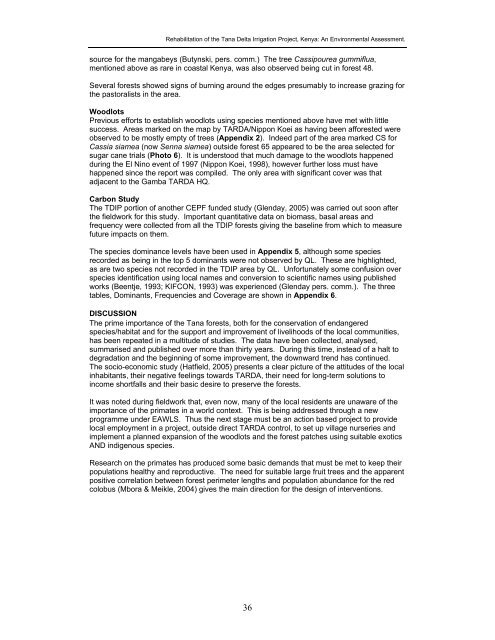Tana Delta Irrigation Project, Kenya: An Environmental Assessment
Tana Delta Irrigation Project, Kenya: An Environmental Assessment
Tana Delta Irrigation Project, Kenya: An Environmental Assessment
Create successful ePaper yourself
Turn your PDF publications into a flip-book with our unique Google optimized e-Paper software.
Rehabilitation of the <strong>Tana</strong> <strong>Delta</strong> <strong>Irrigation</strong> <strong>Project</strong>, <strong>Kenya</strong>: <strong>An</strong> <strong>Environmental</strong> <strong>Assessment</strong>.<br />
source for the mangabeys (Butynski, pers. comm.) The tree Cassipourea gummiflua,<br />
mentioned above as rare in coastal <strong>Kenya</strong>, was also observed being cut in forest 48.<br />
Several forests showed signs of burning around the edges presumably to increase grazing for<br />
the pastoralists in the area.<br />
Woodlots<br />
Previous efforts to establish woodlots using species mentioned above have met with little<br />
success. Areas marked on the map by TARDA/Nippon Koei as having been afforested were<br />
observed to be mostly empty of trees (Appendix 2). Indeed part of the area marked CS for<br />
Cassia siamea (now Senna siamea) outside forest 65 appeared to be the area selected for<br />
sugar cane trials (Photo 6). It is understood that much damage to the woodlots happened<br />
during the El Nino event of 1997 (Nippon Koei, 1998), however further loss must have<br />
happened since the report was compiled. The only area with significant cover was that<br />
adjacent to the Gamba TARDA HQ.<br />
Carbon Study<br />
The TDIP portion of another CEPF funded study (Glenday, 2005) was carried out soon after<br />
the fieldwork for this study. Important quantitative data on biomass, basal areas and<br />
frequency were collected from all the TDIP forests giving the baseline from which to measure<br />
future impacts on them.<br />
The species dominance levels have been used in Appendix 5, although some species<br />
recorded as being in the top 5 dominants were not observed by QL. These are highlighted,<br />
as are two species not recorded in the TDIP area by QL. Unfortunately some confusion over<br />
species identification using local names and conversion to scientific names using published<br />
works (Beentje, 1993; KIFCON, 1993) was experienced (Glenday pers. comm.). The three<br />
tables, Dominants, Frequencies and Coverage are shown in Appendix 6.<br />
DISCUSSION<br />
The prime importance of the <strong>Tana</strong> forests, both for the conservation of endangered<br />
species/habitat and for the support and improvement of livelihoods of the local communities,<br />
has been repeated in a multitude of studies. The data have been collected, analysed,<br />
summarised and published over more than thirty years. During this time, instead of a halt to<br />
degradation and the beginning of some improvement, the downward trend has continued.<br />
The socio-economic study (Hatfield, 2005) presents a clear picture of the attitudes of the local<br />
inhabitants, their negative feelings towards TARDA, their need for long-term solutions to<br />
income shortfalls and their basic desire to preserve the forests.<br />
It was noted during fieldwork that, even now, many of the local residents are unaware of the<br />
importance of the primates in a world context. This is being addressed through a new<br />
programme under EAWLS. Thus the next stage must be an action based project to provide<br />
local employment in a project, outside direct TARDA control, to set up village nurseries and<br />
implement a planned expansion of the woodlots and the forest patches using suitable exotics<br />
AND indigenous species.<br />
Research on the primates has produced some basic demands that must be met to keep their<br />
populations healthy and reproductive. The need for suitable large fruit trees and the apparent<br />
positive correlation between forest perimeter lengths and population abundance for the red<br />
colobus (Mbora & Meikle, 2004) gives the main direction for the design of interventions.<br />
36

















